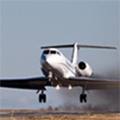Noisy Jets: An end is in sight

With new noise restrictions being introduced at popular private jet airports around the world, is there finally an end in sight for noisy jets?
Farnborough airport – an essential private jet hub to London, have recently tightened noise abatement procedures banning aircraft not compliant with ICAO’s new ‘Chapter 4’ noise rating. See Spotter’s Corner section below for more details.
Aircraft affected by this new restriction at Farnborough include popular types such as the Dassault Falcon 50, Gulfstream 3, Hawker 125-700A and Hawker Beechjet 400.
Top 5 Noisiest Private Jets
| Aircraft | Engine | Year Built | Number in service | |
|---|---|---|---|---|
| 1 | Gulfstream G2 | Rolls Royce Spey | 1966 | 180 |
| 2 | Hawker 600A | Rolls Royer Viper | 1962 | 409 |
| 3 | Sabreliner 60 | Pratt & Whitney JT12A-8 | 1964 | 84 |
| 4 | Learjet 23/24 | General Electric CJ-610 | 1963 | 152 |
| 5 | Beechjet 400 | Pratt & Whitney JT15D-5 | 1978 | 841 |
Noisy private jets from the 1960s and 1970s are rapidly disappearing from the skies over Europe; however they are still very common in North and South America but this is set to change.
The governing aviation authority in the United States, the FAA, has recently passed legislation banning stage 2 private jets from 2016, effectively grounding all Rolls Royce Spey powered Gulfstreams and Viper powered Hawkers, plus early Learjet 23/24/25 models powered by CJ-610 engines.

Stage 3 hush-kits, pictured to the right, can be retro-fitted to old jets like the Gulfstream 2 in order to reduce noise levels and meet the FAA’s new requirements for 2016.
The price of modifying the engines and installing hush-kits however can be half the net worth of the aircraft, which prompts serious questions to owners and operators who currently use these old classic jets.
As new more efficient aircraft become available for private jet charter, it’s great to see aviation authorities taking a pro-active attitude towards corporate jet flights and the environment.
Top 5 Quietest Private Jets
| Aircraft | Engine | Year Built | Number in service | |
|---|---|---|---|---|
| 1 | Eclipse 500 | Pratt & Whitney PW610-F | 2002 | 275 |
| 2 | Cessna Citation Encore | Pratt & Whitney PW535-A | 1969 | 217 |
| 3 | Cessna Citation Mustang | Pratt & Whitney PW615-F | 2005 | 433 |
| 4 | Embraer Phenom 100 | Pratt & Whitney PW617-F | 2007 | 293 |
| 5 | Cessna S550 Citation S/II | Pratt & Whitney PW530-A | 1977 | 150 |
Spotter’s Corner
ICAO ‘Chapter 4’ was introduced in June 2001, following a series of meetings by the ICAO committee on Aviation Environmental Protection (CAEP/5).
ICAO’s council decided on a new ‘Chapter 4’ noise standard, significantly cutting down noise level restrictions from the current ‘Chapter 3’ standard.
ICAO, the International Civil Aviation Organisation state, “In order for an aircraft to qualify for the Chapter 4 standard, the following criteria must be met as a minimum:
- The relevant Chapter 3 noise limit at each certification point (flyover, sideline or approach) must not be exceeded, i.e. no trade-offs between points are permitted;
- Relative to the Chapter 3 standard, the minimum margin at any two certification points must be at least 2 EPNdB;
- Relative to the Chapter 3 standard, the cumulative margin at the three certification points must be at least 10 EPNdB.
“From January 1st 2006, the Chapter 4 standard applies to newly certificated aircraft, although manufacturers may also opt to re-certificate some of their existing Chapter 3 designs to the Chapter 4 standard.”
*Reference CAA
Related content

New ICAO emissions rules: Will China & USA delay?



